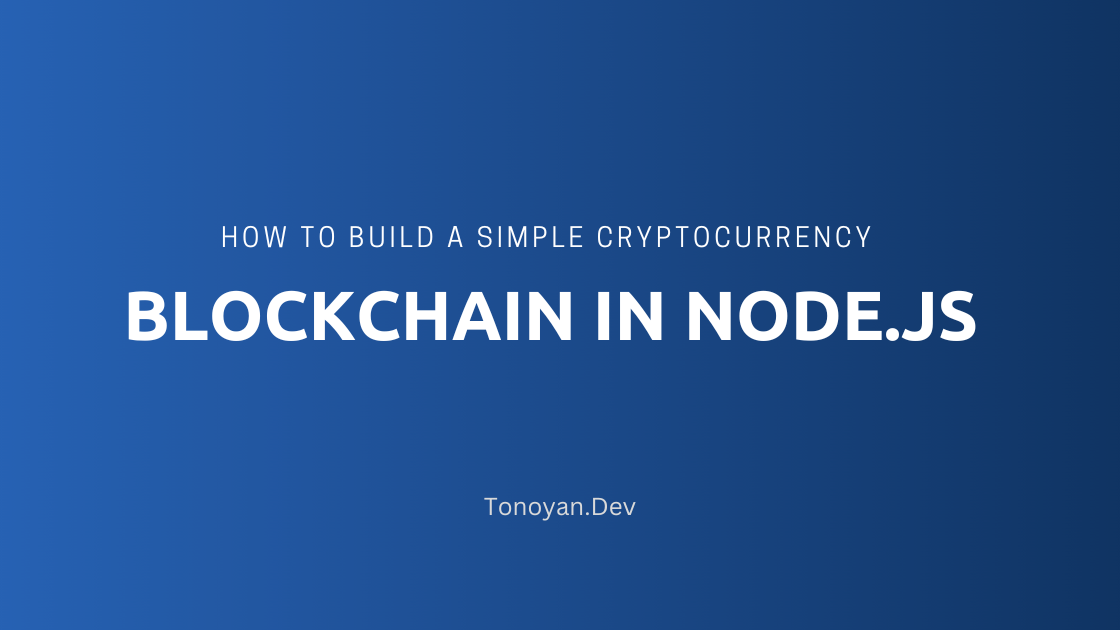How To Build A Simple Cryptocurrency Blockchain In Node.js

- Published on

How To Build A Simple Cryptocurrency Blockchain In Node.js: Your Unnecessarily-Entertaining Guide
Hello, readers! Have you ever been sitting at your computer, gazing out the window, and thought, "Gosh, wouldn't life be grand if I could build a cryptocurrency blockchain in Node.js?" Well, today's your lucky day, my friend! Get ready for a rollercoaster ride that's going to take you from the ordinary world of API endpoints to the mysterious realm of decentralized ledger technology. It's time to chain some blocks together and create our very own crypto! For this tutorial, let's call our cryptocurrency "NodeCoin".

Yes, exactly like that.
Step 1: Setting the stage
First off, you're going to need Node.js and npm installed. If you haven't done that yet, check out the official Node.js download page. You're also going to need your favorite text editor. If you don't have one, that's okay; I'll wait while you take this existential journey to find your favorite. Ready? Alright, let's move on!
Step 2: Initializing our Project
Create a new folder for our project and initialize it with npm. Hop into your terminal or command prompt and do the following:
mkdir NodeCoin
cd NodeCoin
npm init -y
Step 3: Installation of Dependencies
We're going to need 'crypto-js' for creating our hashes, and 'express' for our HTTP server. Install them by running:
npm install crypto-js express
Step 4: Creating our Blockchain
In the root of your project, create a file named 'blockchain.js'. In this file, we're going to design our simple blockchain.
const SHA256 = require('crypto-js/sha256');
class Block {
constructor(index, timestamp, data, previousHash = '') {
this.index = index;
this.timestamp = timestamp;
this.data = data;
this.previousHash = previousHash;
this.hash = this.calculateHash();
}
calculateHash() {
return SHA256(this.index + this.previousHash + this.timestamp + JSON.stringify(this.data)).toString();
}
}
class Blockchain {
constructor() {
this.chain = [this.createGenesisBlock()];
}
createGenesisBlock() {
return new Block(0, "01/01/2023", "Genesis block", "0");
}
getLatestBlock() {
return this.chain[this.chain.length - 1];
}
addBlock(newBlock) {
newBlock.previousHash = this.getLatestBlock().hash;
newBlock.hash = newBlock.calculateHash();
this.chain.push(newBlock);
}
}
Now that's one good-looking blockchain! We've got our basic Block class, complete with a calculateHash() method, and our Blockchain class, with a genesis block maker and a block adder.
Step 5: Testing our Blockchain
Now, let's test our blockchain to see if it holds up.
let NodeCoin = new Blockchain();
NodeCoin.addBlock(new Block(1, "10/05/2023", { amount: 4 }));
NodeCoin.addBlock(new Block(2, "12/05/2023", { amount: 10 }));
console.log(JSON.stringify(NodeCoin, null, 4));
Run your script with:
node blockchain.js
If you see
a beautiful JSON representation of your blockchain in your console, give yourself a pat on the back!
Step 6: Adding Proof of Work (Mining)
Right now, our blockchain is a bit too simple, and blocks can be added all willy-nilly. Let's introduce a proof-of-work algorithm, or as crypto folk like to call it, "mining".
class Block {
// ... previous code ...
mineBlock(difficulty) {
while (this.hash.substring(0, difficulty) !== Array(difficulty + 1).join("0")) {
this.nonce++;
this.hash = this.calculateHash();
}
console.log("Block mined: " + this.hash);
}
}
class Blockchain {
// ... previous code ...
addBlock(newBlock) {
newBlock.previousHash = this.getLatestBlock().hash;
newBlock.mineBlock(this.difficulty);
this.chain.push(newBlock);
}
}
Now, whenever a block is added, it has to be mined, which requires computational power and makes it harder to tamper with the blockchain.
Step 7: Building an API
We're going to create an API for our blockchain. Create a new file, 'main.js', and initialize a simple Express server:
const express = require('express');
const app = express();
const port = 3000;
app.listen(port, () => {
console.log(`NodeCoin listening at http://localhost:${port}`);
});
Run your server:
node main.js
If you see the console message, then congrats! You're a master of Express servers!

You right now.
Step 8: Interacting with our Blockchain
To interact with our blockchain, we're going to need endpoints. Let's start by viewing our blockchain and adding a new block:
app.get('/blockchain', (req, res) => {
res.send(JSON.stringify(NodeCoin, null, 4));
});
app.post('/mineBlock', (req, res) => {
let block = new Block(req.body.index, req.body.timestamp, req.body.data);
NodeCoin.addBlock(block);
res.send(`Block #${req.body.index} has been added to the blockchain!`);
});
Now you have the power to view your blockchain in all its glory and add new blocks to it through a simple API.
And there you have it, folks! You've successfully built a simple cryptocurrency blockchain in Node.js. Yes, it's a basic blockchain, but it's a start. And like any good developer, you're only limited by your imagination (and, well, computational power). So, go ahead and build the next Bitcoin. Or Dogecoin. Or NodeCoin. Or... well, you get the point.

You when NodeCoin takes over the world.
Happy coding!